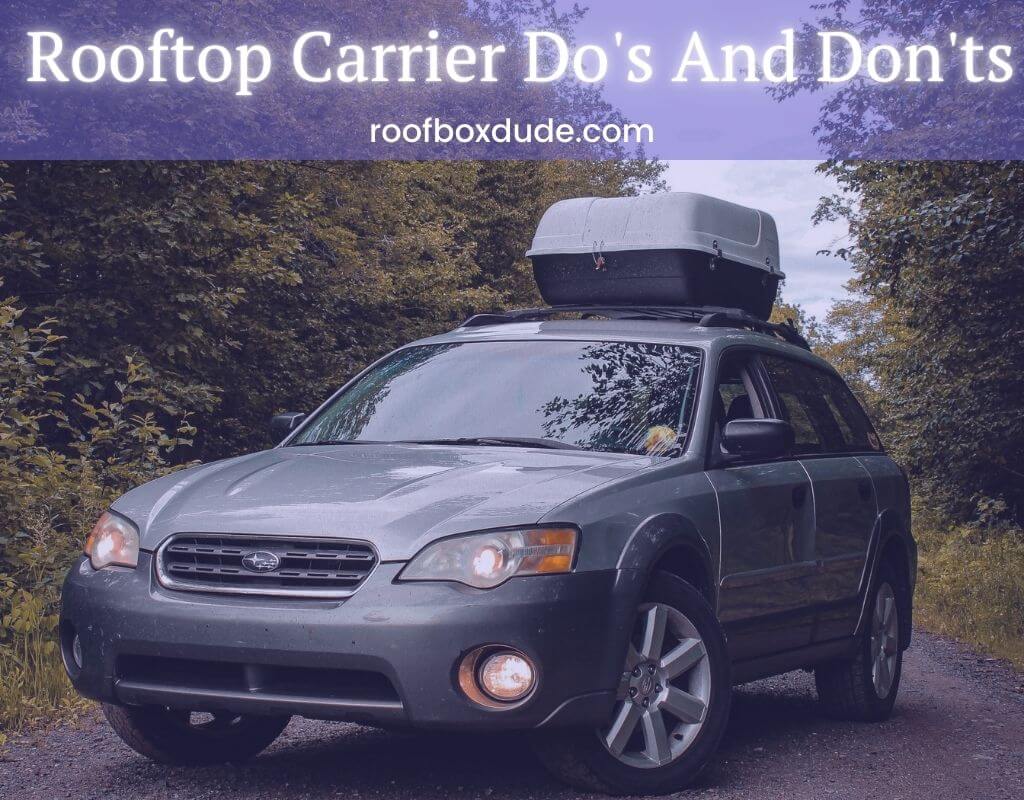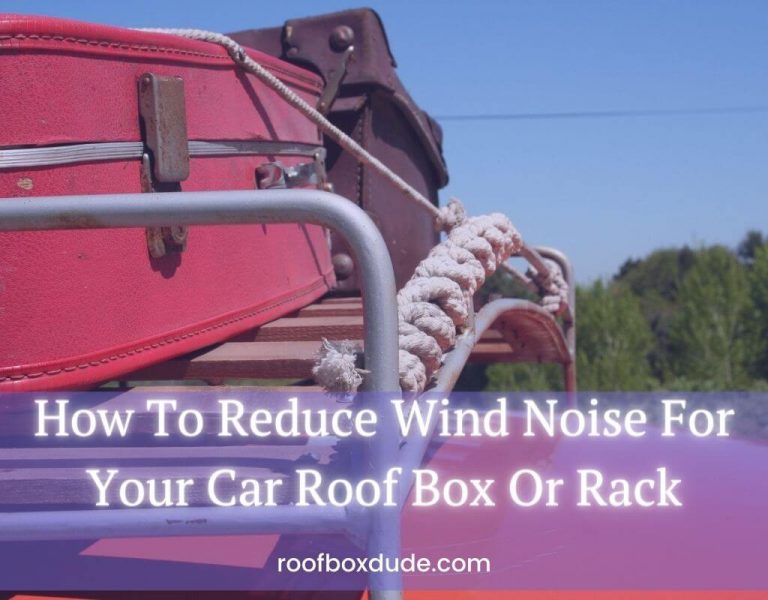Rooftop Carrier Do’s And Don’ts
Introduction
A rooftop carrier can be a great addition to your vehicle if you’re the sort of person who needs to carry lots of extra cargo on a regular basis. Take a look at these rooftop carrier do’s and don’ts before you rush off to purchase a cargo box or fit one before rushing off on your annual camping trip.
Do Consider What Cargo You’ll Be Carrying
If you’re in the market for a new rooftop cargo box for a road trip then the most important thing to decide is what sort of cargo you are likely to be carrying. If you think you might need to carry a bike or a kayak then it’s no good purchasing a full-width cargo carrier. You will need to look for one of the narrower models in order to give you enough space to carry your kayak or bicycle.
If it’s mostly camping gear like sleeping bags then you could possibly get by with a cheaper roof bag. This is especially true if you aren’t likely to need the extra space very often.
If you are carrying skis or snowboards then make sure to buy the right size cargo box.
Do Think About Having A Permanent Carrier Fitted
If you need to carry especially heavy cargo on a regular basis then you might even need to consider having a more permanent solution fitted to your roof. If you did decide to fit a permanent rooftop carrier then it is likely to be made of much sturdier materials so would allow you to carry more. You’ll also have a lot less hassle since you won’t have to install and remove the box on a regular basis.
Obviously, this would be a big step to take since it would mean a permanent increase in the height of your vehicle and a permanent reduction in your fuel economy. This is why most people go for a roof box that can be removed when not needed.
Do Consider Having Your Rooftop Carrier Fitted Professionally
Getting your rooftop carrier fitted by professionals is obviously the hasslefree way to go although of course it will cost you more money.
Don’t Buy A Roof Carrier That Affects Visibility
Try to avoid selecting a roof box that will affect your visibility especially to the front. You also need to think about whether you will be able to access your rear hatch if you purchase a model that extends close to or beyond the rear of your roof.
Do Consult Your Manufacturer’s Handbook
Always check the manufacturer’s documentation regarding what can be carried on your roof. Manufacturers will have tested the load capacity both of the roof and the vehicle in total. Make sure that the cargo box you buy fits within those limits.
Don’t Rush The Job
If you are going to install or remove the cargo carrier yourself then make sure you give yourself plenty of time to do the job properly. Those who fail to prepare, prepare to fail as the saying goes.
Do Read The Instructions
When fitting a rooftop cargo carrier always make sure you read the instructions so that you can install the box safely. If the instructions call for two people then make sure you have someone handy to help you. The same applies when removing the carrier make sure you read the instructions so you don’t damage the box when removing it. Don’t forget to hold onto all of the fixings.
Do Make Sure Your Rooftop Carrier Is Secure
As well as making sure that the box is correctly fitted to your roof bars or roof rack you need to make sure that the lid is adequately secured. The last thing you want to happen is to be driving down the freeway or motorway and find that the lid of your cargo carrier has popped open and your belongings are strewn behind you along the carriageway. Even if you’re lucky and there’s no one behind you it’s still not a great situation to be in and you certainly don’t want to risk causing an accident.
It may be prudent to have some extra cargo straps and fit those before setting off for extra security. It’s probably also worth bringing a couple of spares with you on the trip.
Don’t Carry Inappropriate Cargo In Your Roof Box
As already stated the first thing to avoid is overloading your cargo box in terms of the weight that either the box or the roof or designed to support.
A roof cargo box is primarily designed to carry bulky but light items so try to stick to those sorts of items when loading your rooftop carrier.
Always keep the heaviest items for your trunk. If for no other reason than you will find it difficult to lift them up onto your roof. I would certainly avoid carrying any liquids or hazardous materials no matter what container you may have them in.
Do Make Sure To Load Your Cargo Appropriately
You should always try to evenly distribute the weight within the cargo box to help balance out the load on your vehicle. Always try to strap down items in the carrier so that they aren’t moving about as you drive.
Pack the heaviest items in the truck where possible and leave the lighter stuff for the roof – don’t forget your roof will have a maximum load limit.
Don’t Overload The Roof Box
Stick within the weight limits specified by the roof box manufacturer. Don’t forget that your vehicle will also have a maximum load limit which you need to think about if you are carrying several passengers and lots of equipment.
Don’t Ignore The Weather
While some roof cargo carriers do claim to be waterproof not all of them are. If you’re taking a trip And you haven’t got a waterproof cargo box then you need to plan accordingly. Either avoid putting things in the roof box that would be damaged by water or put them in a waterproof container first.
Do Check Your Tire Pressures
One area of your vehicle that you should pay particular attention to is your tire pressure. With all the extra cargo you’re carrying make sure you follow the recommendations for inflating your tires when under load.
Do Check Your Car Insurance
Double-check with your insurance company to make sure you are covered with a roof cargo box fitted to your vehicle. Many insurance companies are going to consider it a modification so they will need to be informed that you have fitted it. In addition, if you want to be covered for the contents of the vehicle then they would need to know.
Do Take More Care
A surprising number of people will end up driving into their garage or other parking structure and forget they have the roof attached causing damage to their vehicle, the roof box and the garage.
You should also give some consideration to the fact that your car will handle differently with all the extra weight so take more care when driving.
Do Maintain Your Roof Carrier
If you tend to leave your roof in place that is going to end up being exposed to the elements. Make sure that you adequately lubricate the mounting bolts and other fixings to prevent them from going rusty.
Do Get Help When Loading And Unloading
Don’t injure yourself by trying to lift bulky objects in and out of the roof cargo box on your own. Get someone to help you and avoid any strains or other mishaps like scratches to your paintwork.
Don’t Forget Where Your Keys Are
Probably best to add any keys to the keyring where you keep your ignition key. Ideally, take a spare set with you as well just in case.
Don’t Speed
Many, if not most, roof boxes will have a maximum speed recommendation from their manufacturer. Stick to it.
Don’t Drive Tired
This is good advice whether or not you have a roof cargo box fitted. Take regular breaks and give your vehicle and roof box the once over before getting back on the road again.
Rooftop Carrier Do’s and Don’ts: Conclusion
Adding a roof cargo box can be a great way to give you some extra storage space when you’re heading off with the family on your annual vacation. Please try and do it in a responsible fashion by following these do’s and don’ts.
Frequently Asked Questions [FAQ]
How Do I Install A Rooftop Cargo Carrier?
It’s best to follow the instructions provided by the manufacturer. If you are unsure then you might want to visit your local garage or auto store to see if they offer a fitting service.
Usually fitting a cargo carrier is simple if you have two people. Here are some tips on how to fit one.
How Much Luggage Can I Put In My Cargo Box?
That all depends on the maximum weight the box is rated for and also the maximum weight your roof can support.








